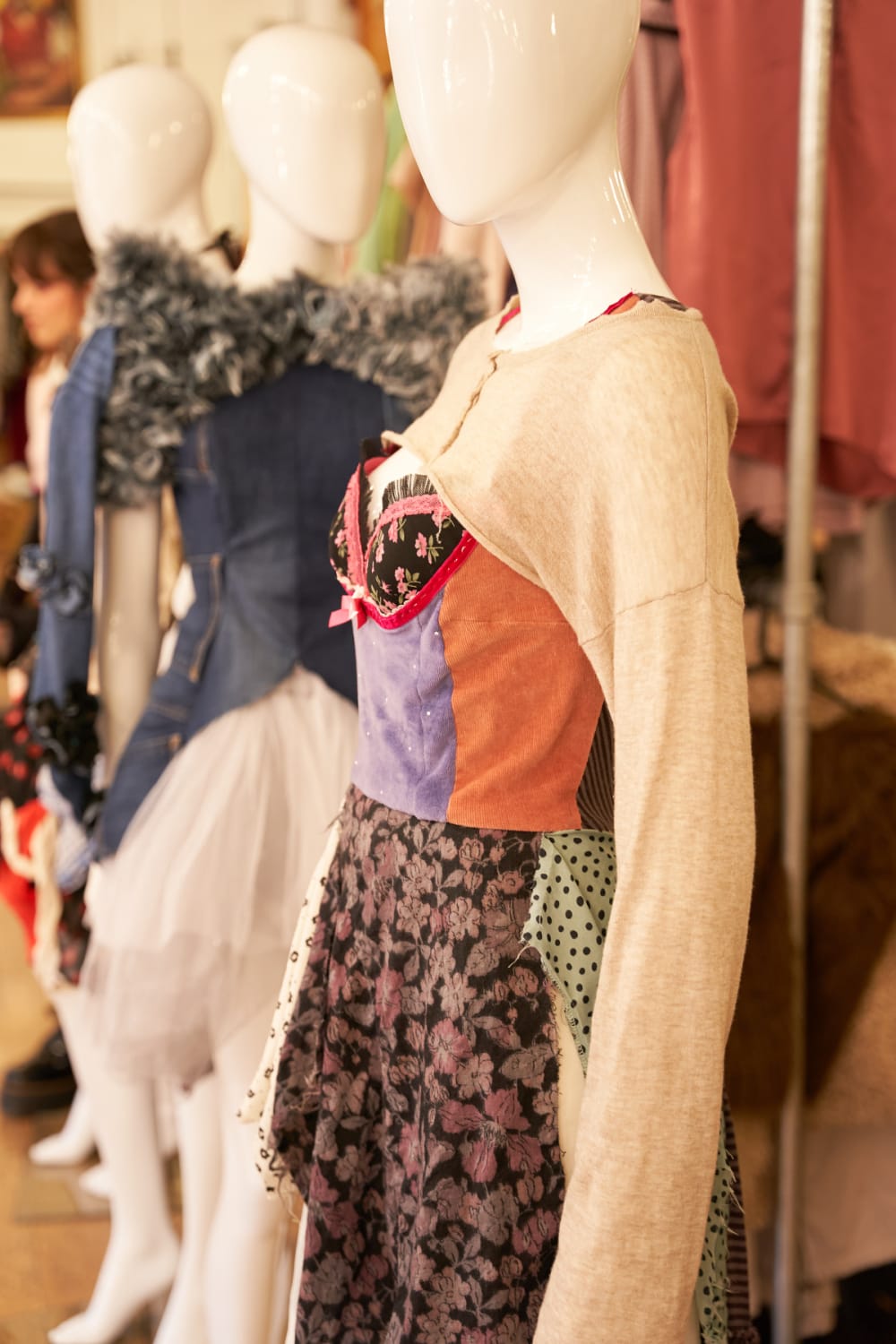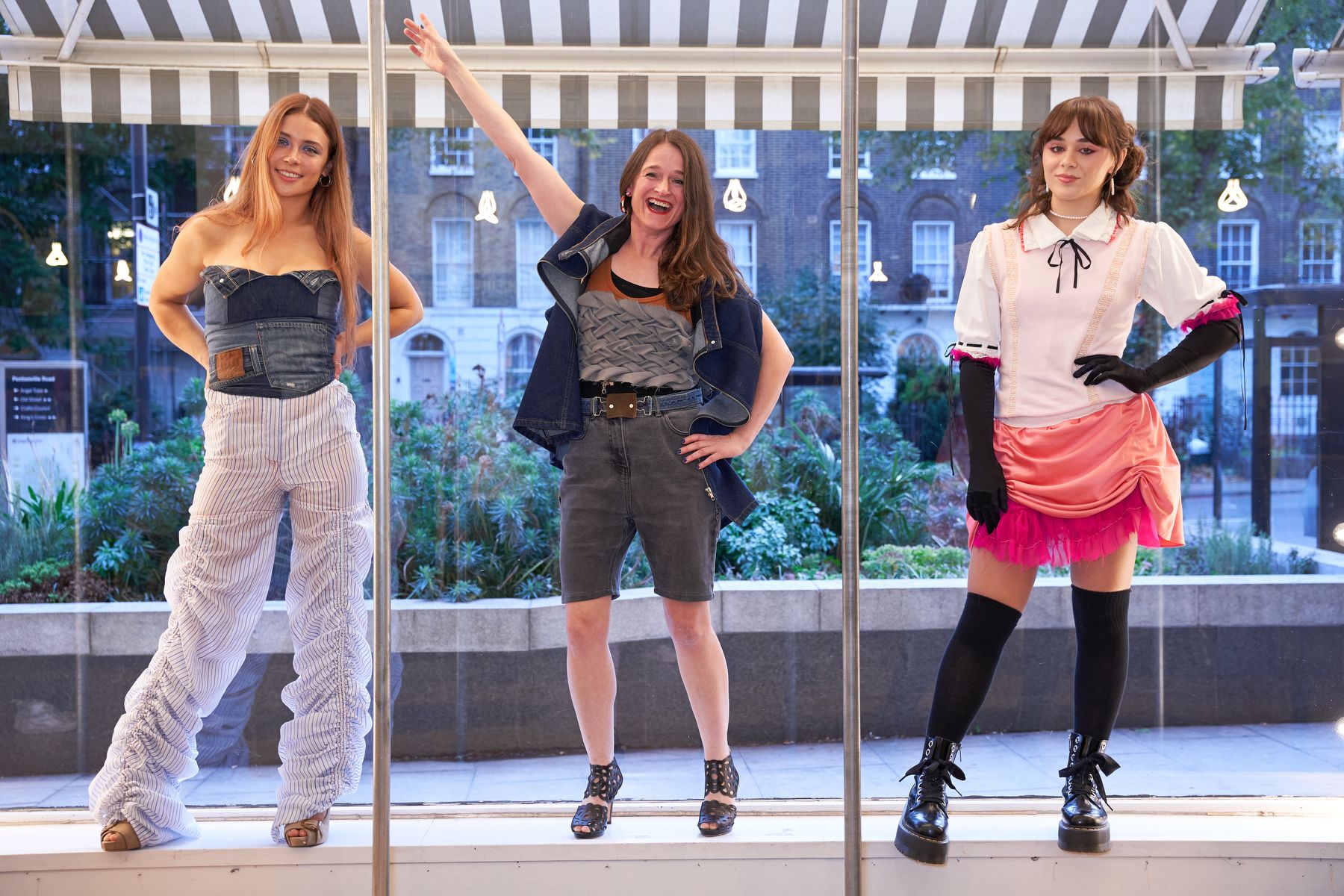
FARA x LCF: Giving new life to old garments

- Written byJ Igiri
- Published date 15 March 2023

As part of our focus on sustainability and social values, London College of Fashion collaborated with pre-loved clothing charity FARA in a project centred on student creativity and ingenuity through upcycling.

Last summer, fourteen BA students from the Product Programme in the School of Design and Technology were given the opportunity to choose from a mountain of deadstock clothes, accessories and fabrics to create new garments inspired by 90s fashion. The final creations were then displayed in FARA’s Islington store windows as part of their 30th-anniversary activities.

Hannah Middleton, Fashion Business School Knowledge Exchange Leader, spoke with Vivian Dodd, a second-year BA (Hons) Fashion Design and Development student and project participant, to find out more about the overall experience.
In conversation with Vivian Dodd
What attracted you to the project?
I'm really passionate about and interested in sustainability, although I've never actually done any upcycling before. I learned a lot in my first year on the course, and I had made a lot of clothes before, but I feel like I'd improved so I wanted to test out what I'd learned with a project of my own.
Which aspect of 90s fashion did you decide to focus on and why?
Although I really didn't want to do denim originally, I ended up doing a lot of denim because I love the material and fabric – especially second-hand when you can see the life it takes on. I tried to do something streetwear-inspired, which is a big part of 90s fashion.
What preloved items did you select from FARA?
I had a lot of tailored suit trousers, I think mostly polyester. I tried to get things with interesting elements like the dungaree clips, and I got some nice jackets with zips that I could use. I also had a few pairs of grey jeans.
I really like the way your product could double up into more than one thing. What sparked that kind of approach?
My first idea was to do a low-waisted skirt and a top that would zip together to become a dress. To me, 90s fashion is low-waisted stuff and I think that's a bit of a trend. So, I thought maybe I could make this trend, but it'll still be valuable and wearable.
Then I realized that if I was putting a zip in the top to connect it to the skirt, I could just zip the top up and it would become a bag!
In the end, I didn't want to commit to a trend or an aesthetic, so I went for full-on transforming clothes because that felt more interesting to me.

To what degree were you focusing on the longevity of the product?
Upcycling really interests me, but it can involve cutting up things that are usable. I wanted to preserve some of the original garments. I think that's why longevity and usefulness were my focus. If you're going into it wanting to do something sustainable, it almost feels like you want something that will last and be a useful garment. I really wanted to improve things.
Do you think the FARA x LCF project changed your view on preloved items?
I think I've always been interested and wanted to wear a lot of second-hand stuff.
This project really reminded me how many second-hand clothes there are, and that a lot of them just need a repair or upcycle to be a useful garment.
I'm definitely keener to repair things. I think that's what I've taken away. It's so interesting to think about the life that clothes have had. It's kind of cool getting your hands on a lot of second-hand clothes and seeing where and how they were worn, and thinking about who wore them in the past.
What do you think you liked most about the project?
I love practical garments and everyday clothes that have some meaning or purpose. A lot of what I made before uni was like that – if I wanted a top, I'd make myself a top.
I think university really pushes you to make the biggest, most conceptual thing that you're working on for months. Even though I still did something that is quite loud, it was cool getting back to a focus on ‘is this useful? Would I wear this every week?’ I think that's what I liked most, I reconnected with what drove me to get into fashion.
You say you like to play with the clothes. Do you have a preference for draping rather than flat pattern cutting?
I loved flat pattern cutting and I did it, but somehow draping has worked a lot better for me this year. I think combining both is what I want to do more of. I definitely get more interesting ideas physically, through draping things, putting things on myself and thinking about them.
Were there any challenges you faced in doing the project?
Working from home was a bit of a challenge. I had a few stretch fabrics which I just really struggled to work with on home-sized machines.
Also not getting feedback, and having to trust myself. There are a lot of times I’m like ‘I have no idea if this is good or bad’ and I keep taking a step back and looking at it and thinking ‘oh it's hideous’.
I really had to trust myself, but I think that was kind of the fun part as well. I made something that's very true to what I wanted to make. It could have been better if somebody gave me some feedback, but at the same time, it's quite nice to build that independence. You've gotta trust your decisions. You've gotta think about everything, you've gotta work how you work.
Can you think of any adjectives that would describe your experience of doing the project?
Exciting would be one. Challenging, tough. Rewarding. I learned a lot working on something on my own, I feel like I've really developed myself as a designer. It was character-building. I think it was a positive challenge.
Photos from this project were courtesy of Rebecca Maynes.
Students involved in the FARA x LCF project will be showcasing their work at Fast Forward 15 charity fashion show planned for Monday 20 March 2023.
- Find out about LCF's Move
- Explore LCF Undergraduate courses
- What’s on at LCF: open days and events